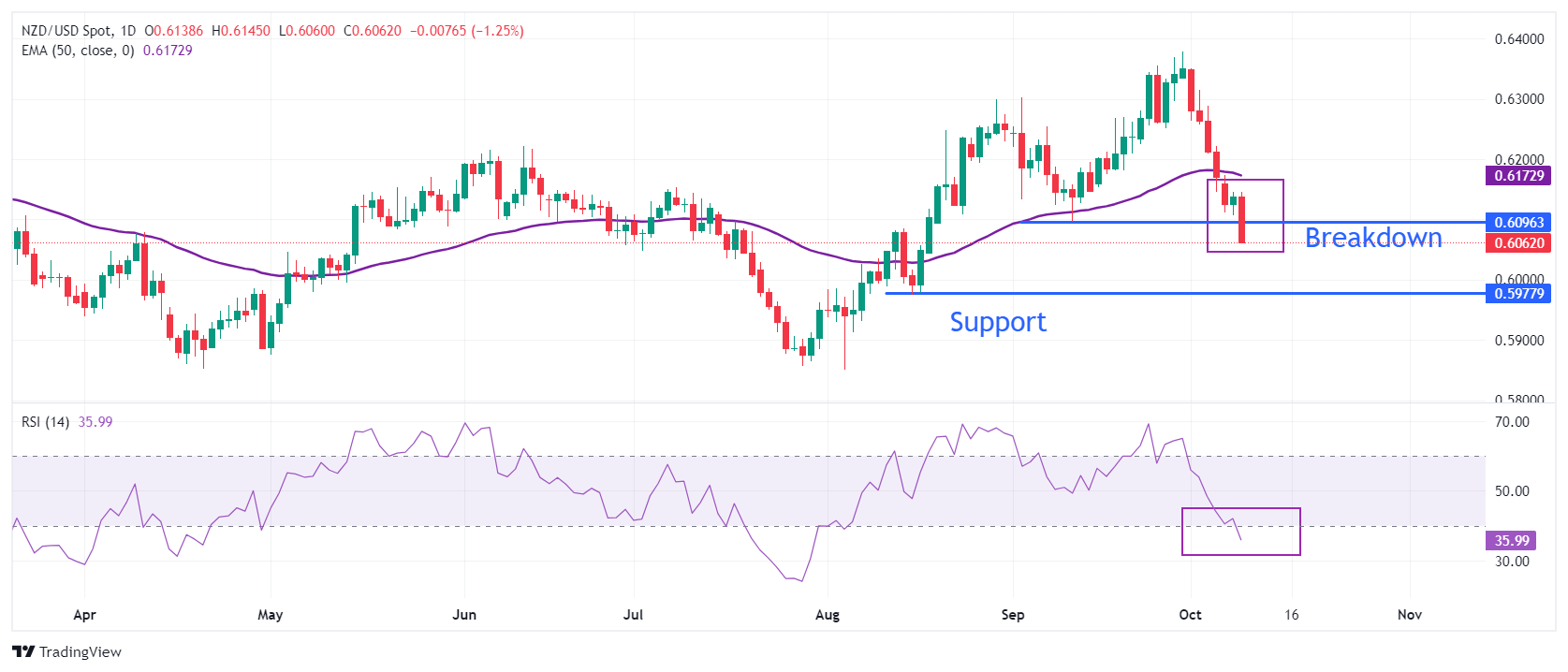- NZD/USD plummets below 0.6100 as the RBNZ reduced its OCR further by 50 bps to 4.75%.
- The RBNZ was expected to deliver a hefty rate cut amid weak growth prospects.
- Investors await the FOMC minutes for fresh cues on the interest rate outlook.
The NZD/USD pair faces an intense sell-off and slides below the round-level support of 0.6100 in Wednesday’s North American session. The Kiwi pair plunges as the Reserve Bank of New Zealand (RBNZ) has cut its Official Cash Rate (OCR) by 50 basis points (bps) to 4.75%.
The RBNZ was expected to deliver a larger-than-usual interest rate cut due to softening labor market conditions and subdued growth. Market participants expect the RBNZ to reduce interest rates at a similar pace again in November.
Meanwhile, dismal market sentiment due to Middle East risks has also dampened the appeal of risk-sensitive assets. The US Dollar Index (DXY), which tracks the Greenback’s value against six major currencies, climbs to near 102.70.
The US Dollar strengthens as traders have priced out the scenario of the Federal Reserve (Fed) to reduce interest rates again by 50 bps in November. The Fed started the policy-easing cycle with a sizeable cut of 50 bps in September. Meanwhile, investors await Federal Open Market Committee (FOMC) Minutes for the September meeting, which will be published at 18:00 GMT.
NZD/USD weakens after breaking below the horizontal support plotted from the September 11 low of 0.6100 on a daily timeframe. The overall trend of the Kiwi pair has become bearish as it has formed a lower swing low. The asset is also trading below the 50-day Exponential Moving Average (EMA), which trades around 0.6173.
The 14-day Relative Strength Index (RSI) slides below 40.00, suggesting that a bearish momentum has been triggered.
More downside is highly likely towards the psychological support of 0.6000 and the August 15 low of 0.5974.
On the flip side, a reversal move above the October 8 high of 0.6146 will drive the asset towards the 50-day EMA at 0.6173 and the October 4 high near 0.6220.
NZD/USD daily chart
Economic Indicator
RBNZ Interest Rate Decision
The Reserve Bank of New Zealand (RBNZ) announces its interest rate decision after its seven scheduled annual policy meetings. If the RBNZ is hawkish and sees inflationary pressures rising, it raises the Official Cash Rate (OCR) to bring inflation down. This is positive for the New Zealand Dollar (NZD) since higher interest rates attract more capital inflows. Likewise, if it reaches the view that inflation is too low it lowers the OCR, which tends to weaken NZD.
Read more.Last release: Wed Oct 09, 2024 01:00
Frequency: Irregular
Actual: 4.75%
Consensus: 4.75%
Previous: 5.25%
Source: Reserve Bank of New Zealand
The Reserve Bank of New Zealand (RBNZ) holds monetary policy meetings seven times a year, announcing their decision on interest rates and the economic assessments that influenced their decision. The central bank offers clues on the economic outlook and future policy path, which are of high relevance for the NZD valuation. Positive economic developments and upbeat outlook could lead the RBNZ to tighten the policy by hiking interest rates, which tends to be NZD bullish. The policy announcements are usually followed by Governor Adrian Orr’s press conference.
Information on these pages contains forward-looking statements that involve risks and uncertainties. Markets and instruments profiled on this page are for informational purposes only and should not in any way come across as a recommendation to buy or sell in these assets. You should do your own thorough research before making any investment decisions. FXStreet does not in any way guarantee that this information is free from mistakes, errors, or material misstatements. It also does not guarantee that this information is of a timely nature. Investing in Open Markets involves a great deal of risk, including the loss of all or a portion of your investment, as well as emotional distress. All risks, losses and costs associated with investing, including total loss of principal, are your responsibility. The views and opinions expressed in this article are those of the authors and do not necessarily reflect the official policy or position of FXStreet nor its advertisers. The author will not be held responsible for information that is found at the end of links posted on this page.
If not otherwise explicitly mentioned in the body of the article, at the time of writing, the author has no position in any stock mentioned in this article and no business relationship with any company mentioned. The author has not received compensation for writing this article, other than from FXStreet.
FXStreet and the author do not provide personalized recommendations. The author makes no representations as to the accuracy, completeness, or suitability of this information. FXStreet and the author will not be liable for any errors, omissions or any losses, injuries or damages arising from this information and its display or use. Errors and omissions excepted.
The author and FXStreet are not registered investment advisors and nothing in this article is intended to be investment advice.
Recommended content
Editors’ Picks

AUD/USD: Further recovery targets 0.6400
AUD/USD soared to three-day highs around 0.6180 on Wednesday, bouncing back from multi-year lows near 0.5900 as easing worries over US tariffs helped fuel the recovery.

EUR/USD: Next on the upside comes the YTD peaks
EUR/USD ended the day with modest loses, coming under renewed downside pressure after hitting tops near 1.1100 the figure on the back of the late bounce in the Greenback.

Gold remains bid, refocuses on $3,100
Prices of Gold now regain some balance and approach the $3,100 zone per troy ounce on Wednesday after President Trump announced a 90-day pause on reciprocal and 10% tariffs. FOMC Minutes pointed to further caution from officials.

Bitcoin, crypto prices pump as Trump pauses tariffs for 90 days
Bitcoin (BTC) and several top cryptocurrencies rallied on Wednesday after President Donald Trump announced the United States (US) would pause its reciprocal tariff on 75 countries following their failure to retaliate and the opening of negotiations with key government agencies.

Tariff rollercoaster continues as China slapped with 104% levies
The reaction in currencies has not been as predictable. The clear winners so far remain the safe-haven Japanese yen and Swiss franc, no surprises there, while the euro has also emerged as a quasi-safe-haven given its high liquid status.

The Best brokers to trade EUR/USD
SPONSORED Discover the top brokers for trading EUR/USD in 2025. Our list features brokers with competitive spreads, fast execution, and powerful platforms. Whether you're a beginner or an expert, find the right partner to navigate the dynamic Forex market.




